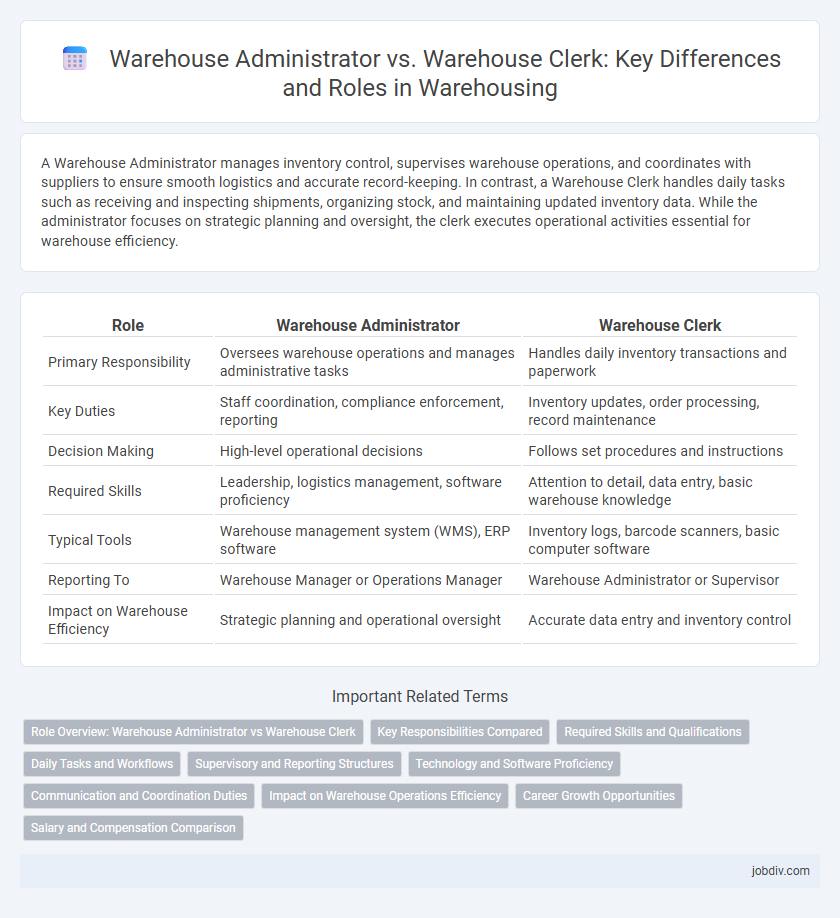A Warehouse Administrator manages inventory control, supervises warehouse operations, and coordinates with suppliers to ensure smooth logistics and accurate record-keeping. In contrast, a Warehouse Clerk handles daily tasks such as receiving and inspecting shipments, organizing stock, and maintaining updated inventory data. While the administrator focuses on strategic planning and oversight, the clerk executes operational activities essential for warehouse efficiency.
Table of Comparison
| Role | Warehouse Administrator | Warehouse Clerk |
|---|---|---|
| Primary Responsibility | Oversees warehouse operations and manages administrative tasks | Handles daily inventory transactions and paperwork |
| Key Duties | Staff coordination, compliance enforcement, reporting | Inventory updates, order processing, record maintenance |
| Decision Making | High-level operational decisions | Follows set procedures and instructions |
| Required Skills | Leadership, logistics management, software proficiency | Attention to detail, data entry, basic warehouse knowledge |
| Typical Tools | Warehouse management system (WMS), ERP software | Inventory logs, barcode scanners, basic computer software |
| Reporting To | Warehouse Manager or Operations Manager | Warehouse Administrator or Supervisor |
| Impact on Warehouse Efficiency | Strategic planning and operational oversight | Accurate data entry and inventory control |
Role Overview: Warehouse Administrator vs Warehouse Clerk
Warehouse Administrators oversee overall warehouse operations, managing inventory control, coordinating shipments, and ensuring compliance with safety regulations. Warehouse Clerks handle daily tasks such as receiving goods, organizing stock, updating records, and preparing orders for dispatch. Both roles are essential for efficient warehouse management but differ in scope, with the Administrator focusing on strategic coordination and the Clerk on operational execution.
Key Responsibilities Compared
Warehouse Administrators oversee overall warehouse operations, including inventory management, staff coordination, and ensuring compliance with safety regulations. Warehouse Clerks focus on specific tasks like receiving shipments, labeling products, and maintaining accurate inventory records. The Administrator role involves strategic planning and reporting, whereas the Clerk handles day-to-day operational duties essential for smooth warehouse function.
Required Skills and Qualifications
Warehouse Administrators typically require strong leadership abilities, proficiency in inventory management software, and expertise in logistics coordination, often holding a bachelor's degree in supply chain management or business administration. Warehouse Clerks need attention to detail, basic computer skills for data entry, and physical stamina, with qualifications generally limited to a high school diploma or equivalent and relevant on-the-job training. Both roles demand knowledge of safety protocols and effective communication skills to ensure smooth warehouse operations.
Daily Tasks and Workflows
Warehouse Administrators oversee inventory management, coordinate shipping schedules, and ensure compliance with safety protocols, focusing on optimizing warehouse operations. Warehouse Clerks handle daily tasks such as receiving goods, sorting shipments, and maintaining accurate records in inventory systems. Both roles collaborate closely to ensure efficient workflow and accurate stock management within the warehouse.
Supervisory and Reporting Structures
A Warehouse Administrator typically oversees overall warehouse operations, managing supervisory staff and ensuring compliance with organizational policies, while a Warehouse Clerk handles daily clerical tasks such as inventory tracking and shipment documentation under the direction of supervisors. In reporting structures, Warehouse Administrators report to warehouse managers or operations directors, providing strategic insights and performance summaries, whereas Warehouse Clerks report to Warehouse Supervisors or Administrators, focusing on accurate execution of tasks and data entry. The distinction in responsibilities emphasizes the Administrator's role in leadership and decision-making contrasted with the Clerk's operational support functions.
Technology and Software Proficiency
Warehouse Administrators oversee complex inventory management systems and utilize advanced warehouse management software (WMS) to optimize operational workflows and data analytics. Warehouse Clerks primarily use basic inventory tracking tools and barcode scanning technology to maintain accurate stock records and support day-to-day logistical tasks. Proficiency in ERP integration and automated reporting platforms differentiates Warehouse Administrators from Clerks by enhancing strategic decision-making capabilities within warehousing operations.
Communication and Coordination Duties
Warehouse Administrators manage communication between departments, vendors, and logistics teams to ensure seamless operations and timely update of inventory data. Warehouse Clerks coordinate daily tasks such as receiving shipments, verifying inventory accuracy, and relaying information to supervisors, maintaining workflow efficiency on the warehouse floor. Effective communication and coordination by both roles are crucial for minimizing errors and optimizing supply chain processes.
Impact on Warehouse Operations Efficiency
Warehouse administrators drive operational efficiency by overseeing inventory management systems, coordinating staff workflows, and implementing process improvements that reduce errors and delays. Warehouse clerks support these efforts through accurate data entry, timely order processing, and routine stock checks, ensuring real-time inventory accuracy. Together, their roles synergize to optimize warehouse throughput, minimize downtime, and enhance overall supply chain performance.
Career Growth Opportunities
Warehouse Administrators typically oversee inventory management, coordinate logistics, and implement operational strategies, positioning them for advancement into supervisory or management roles. Warehouse Clerks handle day-to-day documentation, stock tracking, and order processing, providing foundational experience but with more limited direct career progression. Pursuing certifications in supply chain management or logistics can enhance growth prospects for both roles.
Salary and Compensation Comparison
Warehouse Administrators typically earn higher salaries than Warehouse Clerks, reflecting their greater responsibilities in managing inventory systems and coordinating logistics. The average annual salary for a Warehouse Administrator ranges from $45,000 to $65,000, while Warehouse Clerks usually earn between $30,000 and $45,000. Compensation packages for Administrators often include performance bonuses and benefits such as health insurance, whereas Clerks may receive more basic benefits with fewer bonus opportunities.
Warehouse Administrator vs Warehouse Clerk Infographic

 jobdiv.com
jobdiv.com